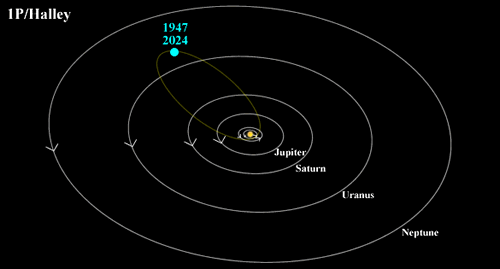Halley-Type Comets
The most famous short-period comet, Halley’s comet, revisits the inner Solar System like clockwork every 76 years. Named after this famous prototype, Halley-type comets (alternatively known as ‘intermediate-period comets’) have orbital periods between 20 and 200 years, and orbits which can be highly inclined to the ecliptic. Both of these observations suggest that Halley-type comets have a different origin to the other class of short-period comet, the Jupiter-family comets, which have shorter periods and lower inclinations.
Jupiter-family comets are thought to be small chunks broken off Kuiper Belt Objects, launched towards the Sun by the gravity of Neptune and further perturbed by the gravity of Jupiter. On the other hand, astronomers believe that Halley-type comets originate much further out in the Solar System, in the spherical Oort Cloud. The icy bodies that make up the Oort Cloud may be perturbed by a passing star or a giant molecular cloud, setting them on highly elliptical paths through the inner Solar System. If these bodies are heavily influenced by the gravitational field Neptune or Uranus during their journey, their orbit may further be altered so that their aphelion distance (and hence, orbital period) is shortened. The result is a Halley-type comet. If their orbit around the Sun is not significantly influenced by the gravity of the giant planets, these objects will remain long-period comets.
There are currently over 60 known Halley-type comets.
Study Astronomy Online at Swinburne University
All material is © Swinburne University of Technology except where indicated.


